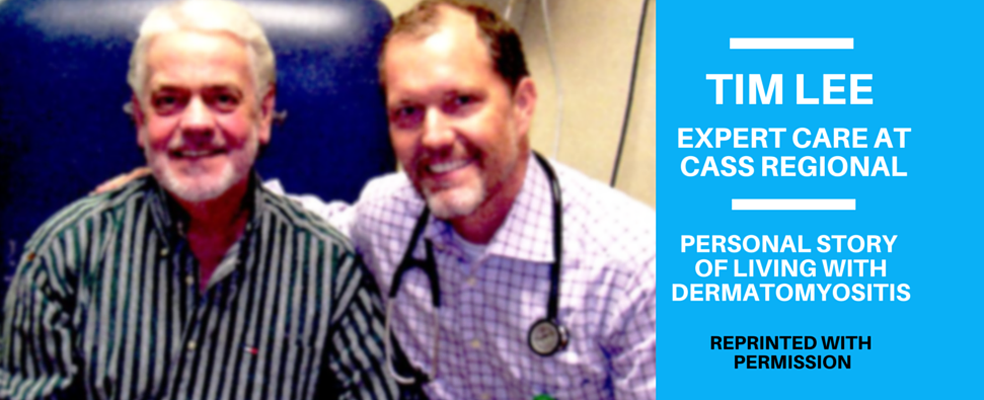Expert Care at Cass Regional Medical Center
Story of Tim Lee, Dermatomyositis patient
The fall of 2008 marked the beginning of what would be a nearly 18-month ordeal of serious and seemingly unrelated illnesses for 52-year-old Tim Lee of Lee’s Summit, Mo. Severe stomach pain sent Tim to an area emergency room for treatment, where doctors ordered several tests, including a chest X-ray that revealed a large tumor in one of Tim’s lungs. Due to the size and location of the tumor, which was cancerous, Tim’s entire lung was removed. Fortunately test results showed no signs that the cancer had spread and he did not have to undergo any further cancer treatment after the lung surgery.
After the tumor had been treated, attention returned to Tim’s stomach pain, which was diagnosed as diverticulitis, an inflammatory disease of the colon. Tim returned to the same Kansas City-area hospital where he had undergone the lung surgery for a procedure to remove the diseased part of his colon. However, his pain continued, so he was admitted to another Kansas City hospital and a second surgery was performed. The second surgery resulted in an infection and ultimately Tim had to have a colostomy, which involves bringing the colon through the abdominal wall and allowing stool to drain into an external bag. This allowed the remaining diseased part of the colon to heal.
After Tim had sufficiently recovered from the infection and surgeries, he returned to the hospital that had performed his first bowel surgery to have the colostomy reversed. The procedure, which usually takes approximately four hours, took 12 hours due to the remaining inflammation and disease the surgeon found. Tim awoke to find that while the colostomy had been reversed, he now had an ileostomy, which is similar to a colostomy but involves the lower small intestine instead of the colon.
Countless Tests
Shortly after Tim returned home in early 2009, his eyes became matted shut due to an unexplained discharge from a rash on his eyelids, and he went to his family doctor for help. He was referred to an eye doctor, who could find no related eye problem and sent him back to his family doctor. Tim’s wife, Kathy, took him to the emergency room at the hospital that had performed his lung surgery, but neither could have foreseen that that visit would be the beginning of a 10-month stay in the facility.
“I was admitted to the hospital and underwent countless tests,” remembers Tim. “During this time, more symptoms appeared. My muscles became weak and eventually I lost the ability to speak, to eat and to sit up. I had rashes on my chest and arms and the discharge that had started on my eyelids was now also coming from the back of my head.”
During the course of Tim’s hospitalization, multiple specialists examined Tim, but none could zero in on a diagnosis to explain his bizarre symptoms. “There were at least 20 doctors who saw Tim,” remembers Kathy. “All the while, we just grew more and more frustrated and discouraged.” Kathy was by Tim’s side every day and night, logging many miles between their home in Lee’s Summit and the hospital in Kansas.
Not ready to give up
After months of tests with no diagnosis, doctors eventually told Kathy that there was nothing more they could do to help Tim. In January 2010, they advised her to find a long-term care facility for him, but she was not ready to give up. She called a friend at her insurance company for a recommendation on where to go for another opinion, and her friend suggested Cass Regional Medical Center.
“We had never been to Cass Regional, and I knew it was a much smaller hospital than the one we were leaving, but at that point, I was willing to give anything a try,” said Kathy. She drove Tim to the Emergency Department at Cass Regional, where he was seen by physician Jeffrey VanBiber, MD, and staff.
Caring at Cass Regional
“Immediately I could tell there was something different about this hospital and its staff,” said Kathy. “And believe me, I had spent a lot of time in hospitals and ERs at that point. There was just a genuine sense of caring at Cass Regional,” she said.
Dr. VanBiber and his team worked diligently to get Tim’s medical records from the hospital he had just left, and Tim was admitted to Cass Regional that evening.
“When I was first admitted into Cass Regional I had a couple of reservations on my mind,” remembers Tim. “One, it being a smaller hospital, and two, experience. Well, within 24 hours both of those myths were completely shot out of the water.”
The next morning, Christopher Maxwell, MD, who works as a family physician at Kingsville Medical Clinic, was making rounds on the hospitalized patients and came to Tim’s room. “I remember thinking, ‘oh boy, we already came to a smaller town and now we’re getting a doctor from Kingsville!’,” laughs Tim. However, after examining Tim, Dr. Maxwell made a decision that very well saved Tim’s life.
Diagnosis of Dermatomyositis
“He said, ‘there’s a doctor I want you to see – I think he might be able to help you’,” said Tim. That doctor was Kevin Latinis, MD, PhD, Cass Regional’s rheumatologist. Dr. Maxwell suspected Tim’s symptoms might be the result of an autoimmune disorder, which is an area that Dr. Latinis specializes in. When Dr. Latinis saw Tim, he quickly diagnosed the culprit behind Tim’s symptoms – a rare disease called dermatomyositis.
“Dermatomyositis affects about 10 out of every 1 million people,” explained Dr. Latinis. “I generally see a few new patients with it each year, and I’ve managed many with the chronic disease over the years.” Dermatomyositis is characterized by chronic muscle inflammation and muscle weakness, and a skin rash that precedes, accompanies or follows progressive muscle weakness. People with dermatomyositis may also develop calcium deposits, which appear as hard bumps under the skin or in the muscle. Tim also experienced this condition, known as calcinosis.
Dr. Latinis prescribed several infusions of intravenous immunoglobulin, or IVIG. “IVIG is used for severe cases of dermatomyositis,” said Dr. Latinis. “It is thought to block the massive immune chain reaction by occupying all the receptors for antibodies. It also helps fight off infections at the same time, so it is an ideal treatment for someone who is very sick in the hospital with multiple problems, including severe autoimmune disease,” he continued.
The longest wait
“I had to wait over a weekend for the IVIG to arrive from Tennessee, which was the longest wait of my life,” said Tim. Almost immediately, the IVIG infusions began to counteract the dermatomyositis, but the prolonged muscle weakness had left Tim unable to speak or swallow, and he could barely walk or move his arms. He began undergoing therapy with speech-language pathologist Nora Dahman, MS, CCC-SLP, and physical therapist John Hoffman, PT.
“Since I had lost the ability to eat, I had a feeding tube and had lost over 100 pounds,” said Tim. Using neuromuscular electrical stimulation therapy, Nora worked with Tim to retrain his muscles to swallow. “The day we were in the fluoroscopy room and Kathy and I could actually see Tim swallow liquid for the first time in months, I think we were all crying,” said Nora. “That was such a victory for Tim.”
John Hoffman worked with Tim to regain his strength for daily activities, such as walking. “The day before Tim was discharged, John had him running up and down the stairs,” remembers Kathy with a smile. “He was great.”
Tim left Cass Regional shortly before Valentine’s Day. He continued to return for regular outpatient visits to Dr. Latinis and therapy with Nora and John. And in August 2010, he was able to drive again and return to work after an absence of over a year.
Forever Grateful
Today, Tim continues to see Dr. Latinis every three months for a checkup. “Dermatomyositis can be effectively managed in most patients,” explained Dr. Latinis. “As in Tim’s case, the biggest problem is usually recognizing the disease in the first place. Most patients can be treated and get their active dermatomyositis in remission or with low activity but recurrence and flares can be common. This is also a disease that is associated with a much higher incidence of cancer, which Tim has experienced, so we need to keep up with careful cancer screening throughout his life, even when the dermatomyositis is doing well.”
Tim and Kathy are grateful for the care they received at Cass Regional. “The one on one from everyone was second to none,” said Tim. Kathy added, “When Tim was in the hospital here, I finally felt comfortable leaving him to go home at night. I trusted the nurses to take care of him.”
“The entire hospital is something to be very proud of,” Tim said. “I see all these cars driving past Cass Regional on I-49, and I know some of them are headed to hospitals in Kansas City. Why? There’s a great hospital with great doctors right here, and I am living proof of that.”
This is the text version of an article featured in Cass Regional’s Newsletter. Tim Lee, a patient with dermatomyositis, was interviewed and Myositis Support and Understanding has been given permission to post this article. You can download the original, PDF version below.
We thank Tim Lee for sharing his story with us.
Tags: myositis story









